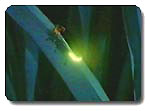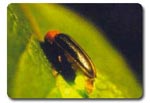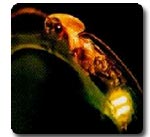
Firefly Habitats & Behaviors
Fast Facts of Firefly (Lightning Bug)
Type: Bug
Common Names: Firefly, Lighting Bug & Glow Worm
Family: Lampyridae

Habitats & Behaviors of Firefly
Commonly known as fireflies, glow worms, or lightning bugs, they are tiny, brown color beetles in the family of Lampyridae. Fireflies are winged beetles that their lower abdomen can produce yellow, green, or pale-red lights, with wave lengths from 510-670 nanometers. Today, there are about 2,000 species of firefly species found in a variety of warm or temperate environments, and tropical regions that contain rich food source. The highest firefly species diversity are found mostly on summer evening in moisture and humid regions of Asia and the Americas, as well as wet and damp areas that retain moisture. Fireflies can now be found in many Taiwan destinations, such as Yanmingshan National Park and Wulai area of Taipei, Neiwan and Beipu areas of Hsinchu, Sun Moon Lake and Xitou (Sitou) Forest Recreation Area in Nantou, Alishan Forest Recreation Park in Chiayi, Kenting National Park in Pintung and many other areas in Taiwan for one to experience an unforgettable Taiwan travel surrounded by these tiny, flickering fireflies. Alishan National Park is gifted with a perfect environment, where fireflies can be seen all-year-round, including winter fireflies that are rare and precious, and can only be found in Taiwan, Japan, India, Himalaya Mountains and Tibetan plateau.
Both female and male fireflies are similar in appearance in some species. These females can often be distinguished from the larvae for they have compound eyes. Most of the fireflies are nocturnal, though there are a number of species that are diurnal. For diurnal species, they are non-luminescent mostly, though some species that remain in shadowy, shady areas have the ability to produce light.
Earthworms, snails, and slugs are main foods of firefly larvae. Firefly larvae are predaceous with ability to detect the slime trail of slug or snail, and follow it to the prey. Firefly larvae would inject numbing fluid through hollow ducts in their mandibles into their prey to immobilize and eventually digest it. During the adult stage of firefly, they are mostly fed on plant nectar in order to sustain their energy that can last several months or longer.

Terrestrial & Aquatic Firefly
Firefly larvae are divided into 2 main groups: terrestrial and aquatic fireflies according to their habitats.
Terrestrial firefly species inhabit mainly moist grasslands and deserted farmlands that are rich in terrestrial vegetation. Terrestrial firefly larvae are mainly fed on snails, earthworms, slugs, and collembolans. Terrestrial firefly larvae would follow the prey’s path and inject numbing fluid to until pretty is numbed. Then, they would digest them mouthful by mouthful. It takes about a day or 2 for firefly larvae to digest and leave their prey. For female terrestrial fireflies, they can mate with a male immediately after emergency and with several different males.
Different from terrestrial firefly larvae, aquatic fireflies has different habitat during each stage. Aquatic firefly larvae inhabit mainly on shore, while adult females and males tend to be found around water such as ponds, streams, marshes, and other areas that may retain moisture longer then surrounding areas. After mating, female aquatic fireflies lay eggs on shore. Today, the continuing evolvement and expansion of land have destroyed the habitats of fireflies, it's hard for larvae to find the right place to pupate, and females to lay their eggs. The main food sources of aquatic firefly larvae are shellfish, water snails, and aquatic insects. They prey similar to the terrestrial fireflies, follow them, inject numbing fluid at preys, and digest them mouthful by mouthful.
Biological Profile of Firefly
Light & Chemical Production of Firefly
Light production of fireflies is produced by a chemical reaction called bioluminescence. Fireflies produce their signature glow through their specialized light-emitting organs that are usually located in their lower abdomens. They take in oxygen and combine it with “luciferin”- the substance to produce light with almost no heat, inside special cells.
Purposes of Firefly Light

The main purpose of firefly light is to attract mate. Firefly light is usually intermittent that flashes in patterns to differentiate from other species. The particular blinking pattern is an optical signal for fireflies to find potential mates. Males and females of the same species would flash signals back and forth as a way of communication. A female would answer with her best flash when she recognizes the flash from a male of the same species.
During mating, both male and female would light up at the same time. Mating may last for a period of time even up to hours. Males pass away in a few days after mating, while females decease after laying eggs. A few days later after mating, the female firefly would deposit her fertilized eggs on or just below the surface of the ground, where larvae would develop to adulthood. Larvae are fed on worms and slugs by injecting them with a numbing fluid.
Another purpose of the firefly light is to prevent attack from predators. Fireflies are filled with an unappetizing chemical that when predator attacks, it quickly glows with this nasty taste that will keep the predators to stay away.
Firefly Facts
1. How do fireflies glow?Travel Tips for Firefly Tours
- Wear long pants and long sleeves shirts to avoid mosquito bites.
- Wear skid-proof shoes or rain boots for your safety.
- Fireflies can hardly be spotted during rainy season, foggy day, and cold snap as the rough weather may affect their motility.
- Fireflies are best-seen after sun sets in the evening around 18:00-20:00.
- Do not point at fireflies directly with your torch, and torch should be covered with cellophane.